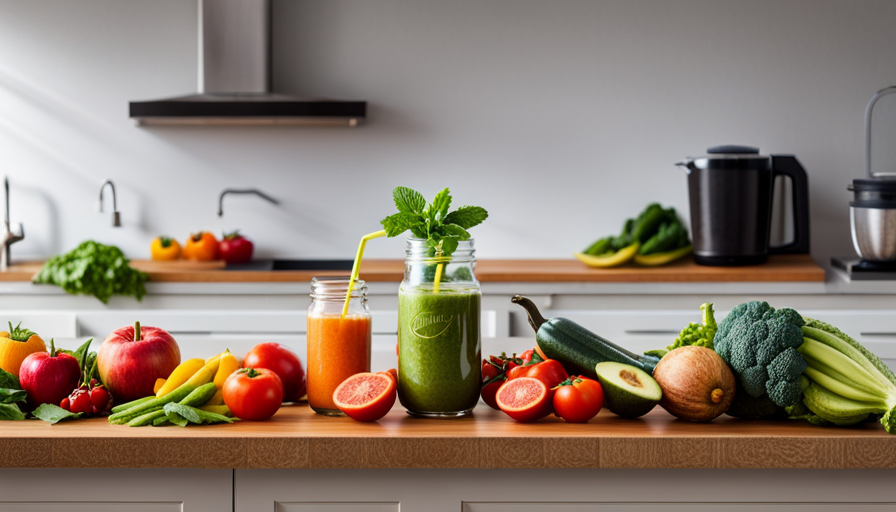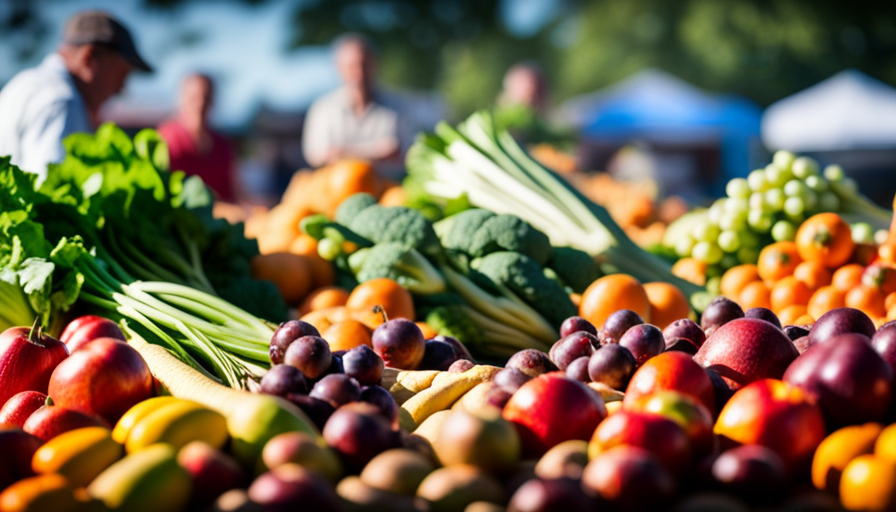Have you been aware that adding more raw fruits and vegetables to your diet can greatly enhance your overall health? A study carried out by the Journal of Nutrition reveals that a diet rich in raw foods can boost your intake of vital nutrients, reduce cholesterol levels, and potentially aid in weight loss.
If you’re interested in transitioning to a raw food diet but aren’t sure where to start, you’ve come to the right place. In this article, we will guide you through the process of easing into a raw food diet, step by step. We’ll explore the benefits of a raw food diet, offer practical tips for incorporating more raw fruits and vegetables into your meals, provide delicious raw food recipes and meal ideas, and address common challenges you may face along the way.
By the end of this article, you’ll have the knowledge and tools to embark on your raw food journey with confidence and ease.
Key Takeaways
- Transition to a raw food diet can be done gradually, step by step.
- Incorporate more raw foods into meals and experiment with different recipes.
- Take shortcuts by using pre-cut fruits and vegetables for convenience.
- Stay hydrated to support digestion and promote healthy skin.
Understanding the Raw Food Diet
Are you tired of feeling sluggish and bloated? It’s time to understand the amazing benefits of the raw food diet and how it can transform your health and well-being.
The raw food diet is all about consuming fresh, unprocessed, and uncooked foods. By eating raw, you’re ensuring that your body receives all the essential nutrients, enzymes, and vitamins in their natural state, as cooking can often destroy these vital elements.
Understanding the raw food diet is key to its successful implementation. Contrary to common misconceptions, it isn’t just about eating salads and fruits. It includes a wide variety of raw foods such as vegetables, nuts, seeds, sprouts, and even fermented foods like sauerkraut and kimchi. The diet emphasizes the consumption of whole, plant-based foods, which are rich in fiber, antioxidants, and phytonutrients.
Debunking common misconceptions is also important when it comes to the raw food diet. Many people believe that it’s difficult to get enough protein on a raw food diet, but this isn’t true. Plant-based sources like almonds, hemp seeds, and chia seeds are excellent protein sources. Another misconception is that raw food is tasteless, but with the right preparation and seasoning, raw meals can be delicious and satisfying.
Understanding the raw food diet and debunking common misconceptions sets the foundation for successfully incorporating this lifestyle into your routine. By embracing the raw food diet, you can experience increased energy levels, improved digestion, weight loss, and enhanced overall health. So why wait? Start enjoying the benefits of a raw food diet today!
Benefits of a Raw Food Diet
Discover the amazing advantages you’ll experience when embracing a lifestyle centered around nourishing, unprocessed, and vibrant ingredients. A raw food diet offers numerous benefits that can improve your overall health and well-being. One of the biggest advantages is weight loss. Raw food is typically low in calories and high in fiber, which helps you feel full and satisfied while consuming fewer calories. Additionally, raw food is rich in enzymes, which aids in digestion and boosts metabolism, leading to weight loss.
But weight loss is just the beginning. A raw food diet also provides an abundance of vitamins, minerals, and antioxidants, which support a strong immune system and reduce the risk of chronic diseases. These nutrients are preserved in their natural state, offering maximum nutritional value. Moreover, the high water content in raw fruits and vegetables promotes hydration and healthy skin.
To further illustrate the benefits of a raw food diet, here is a table showcasing some of the advantages:
| Benefits of a Raw Food Diet |
|---|
| Weight Loss |
| Improved Digestion |
| Increased Energy |
| Enhanced Immunity |
| Radiant Skin |
As you can see, a raw food diet can do wonders for your health and well-being. By incorporating more raw, unprocessed foods into your diet, you’ll not only shed pounds but also enjoy an array of other benefits that will leave you feeling vibrant and nourished.
Transitioning to Raw Food: Taking it Slow
Take a tantalizing journey towards a vibrant, nourishing lifestyle by slowly embracing the raw food movement. Transitioning to a raw food diet can be a gradual and rewarding process. Here are some tips to help you ease into it:
-
Start by incorporating more raw foods into your meals. Begin by adding a side salad or a raw vegetable snack to your daily meals. This will help you get used to the taste and texture of raw foods.
-
Experiment with different recipes. Explore the world of raw food recipes and find ones that appeal to your taste buds. This’ll make your transition more enjoyable and help you discover new flavors and textures.
-
Take shortcuts. Don’t feel like you have to make everything from scratch. Utilize pre-cut fruits and vegetables, or buy pre-made raw food snacks and meals to make the transition easier.
-
Avoid common mistakes. One common mistake is not getting enough variety in your diet. Make sure to include a wide range of fruits, vegetables, nuts, and seeds to ensure you’re getting all the necessary nutrients. Another mistake is not staying hydrated. Drinking plenty of water is crucial for optimal digestion and overall health.
By taking it slow and following these tips, you can ease into a raw food diet and reap its numerous health benefits.
Incorporating More Raw Fruits and Vegetables
Embrace a vibrant and nourishing lifestyle by gradually incorporating more raw fruits and vegetables into your meals. Transitioning to a raw food diet can be challenging, but with these tips, you can make the process smoother.
One of the easiest ways to start is by adding raw fruits and vegetables to your favorite dishes. For example, you can top your salad with fresh berries or slice cucumbers and carrots as a side dish. Another option is to replace processed snacks with raw fruits, such as apples or grapes. This will not only increase your intake of raw foods but also provide you with essential vitamins and minerals.
To make the transition even easier, try experimenting with different flavors and textures. Blend raw fruits and vegetables to make delicious smoothies or juices. You can also create raw food versions of your favorite dishes, like zucchini noodles or cauliflower rice. Additionally, consider joining a raw food community or finding a mentor who can offer guidance and support throughout your journey.
While incorporating more raw fruits and vegetables into your diet is beneficial, it’s important to be aware of the challenges that may arise. Raw food diets can be low in certain nutrients, such as protein, iron, and calcium. Therefore, it’s crucial to plan your meals carefully to ensure you’re getting all the necessary nutrients. Consider consulting with a registered dietitian to ensure your diet is well-balanced and meets your nutritional needs.
By gradually incorporating more raw fruits and vegetables into your meals, you’ll be on your way to embracing a vibrant and nourishing raw food lifestyle. Remember to start small, experiment with flavors, and seek support when needed. With these tips in mind, you can successfully transition to a raw food diet and enjoy the numerous health benefits it offers.
Exploring Raw Food Recipes and Meal Ideas
Try out these delicious and creative recipes that’ll inspire you to incorporate more raw fruits and vegetables into your meals. Eating raw doesn’t mean you have to sacrifice taste or variety. In fact, there are plenty of raw food recipes and meal ideas that are both nutritious and satisfying.
Here are some ideas to get you started:
-
Raw Food Desserts:
-
Raw Chocolate Avocado Mousse: This creamy and decadent dessert is made with ripe avocados, raw cacao powder, and a touch of sweetener. It’s a healthy alternative to traditional chocolate mousse.
-
Raw Coconut Macaroons: These bite-sized treats are made with shredded coconut, almond flour, and sweetened with dates. They’re packed with flavor and perfect for satisfying your sweet tooth.
-
Raw Food Snacks:
-
Raw Vegetable Sushi Rolls: Instead of using traditional sushi rice, these rolls are made with thinly sliced vegetables like cucumber, carrot, and avocado. They’re refreshing, crunchy, and packed with nutrients.
-
Raw Energy Balls: These little snacks are made with a combination of nuts, dates, and other dried fruits. They’re easy to make and great for when you need a quick burst of energy.
Incorporating raw food desserts and snacks into your diet can help you satisfy your cravings while still sticking to a raw food lifestyle. Give these recipes a try and discover how delicious and satisfying raw food can be.
Building a Balanced Raw Food Plate
To create a balanced raw food plate, you’ll want to include a variety of colorful fruits and vegetables, along with plant-based proteins and healthy fats. Eating a variety of fruits and vegetables ensures that you get a wide range of essential vitamins, minerals, and antioxidants. When it comes to plant-based proteins, options such as nuts, seeds, and legumes can provide the necessary protein your body needs. Healthy fats, like avocados and coconut oil, are important for brain function and energy production.
To help you visualize how to build a balanced raw food plate, here is a simple table to guide you:
| Fruits | Vegetables | Proteins |
|---|---|---|
| Berries | Leafy greens | Nuts |
| Citrus fruits | Bell peppers | Seeds |
| Melons | Carrots | Legumes |
In addition to these basic guidelines, it’s important to make raw food substitutions for any cooked ingredients. For example, you can use cauliflower rice instead of regular rice, or zucchini noodles instead of pasta. By incorporating these raw food substitutions, you’ll be able to maintain the integrity of a raw food diet while still enjoying your favorite meals. Remember, balance is key when it comes to any diet, and with careful planning and creative substitutions, you can easily build a balanced raw food plate.
Ensuring Proper Nutrient Intake on a Raw Food Diet
Ensuring proper nutrient intake on a raw food diet can be achieved by carefully planning and incorporating a variety of colorful fruits, vegetables, plant-based proteins, and healthy fats into your meals. This is crucial because a poorly planned raw food diet may lead to nutrient deficiencies. Here are some tips to help you maintain a balanced nutrient intake:
-
Include a variety of fruits and vegetables: Different colors represent different nutrients, so aim to have a colorful plate. For example, orange fruits and vegetables like carrots and oranges are rich in vitamin C and beta-carotene, while leafy greens like spinach and kale provide iron and calcium.
-
Incorporate plant-based proteins: Legumes, nuts, and seeds are excellent sources of protein on a raw food diet. Include foods like lentils, chickpeas, almonds, and chia seeds to ensure you meet your protein needs.
-
Don’t forget healthy fats: Avocados, coconut oil, and nuts are great sources of healthy fats. These fats are essential for nutrient absorption and provide long-lasting energy.
Meal planning is essential to ensure you are getting a wide range of nutrients. It’s a good idea to consult a registered dietitian or nutritionist who can help you create a balanced meal plan that meets your specific nutrient requirements. By following these tips and planning your meals carefully, you can enjoy the benefits of a raw food diet while ensuring proper nutrient intake.
Overcoming Challenges and Staying Motivated
Staying motivated and overcoming challenges on a raw food journey can be as invigorating as climbing a majestic mountain peak. While transitioning to a raw food diet may bring numerous health benefits, it can also present obstacles that may test your commitment.
However, with the right mindset and strategies, you can stay motivated and overcome these challenges.
One way to stay motivated is by setting clear goals. Define why you want to embark on this journey and remind yourself of these reasons regularly. You can also track your progress by keeping a journal or using an app to monitor your food choices and how you feel after each meal.
Another crucial aspect is finding support. Surround yourself with like-minded individuals who can provide encouragement and share their own experiences. Joining online communities or attending local raw food meetups can be great ways to connect with others.
Additionally, it’s important to be prepared for obstacles. Raw food diets may require more time for meal preparation and planning. To overcome this challenge, dedicate some time each week to meal prepping and experimenting with new recipes. Also, ensure you have access to fresh, high-quality produce by exploring farmers’ markets or joining a community-supported agriculture program.
Remember, staying motivated and overcoming obstacles is a journey in itself. Celebrate your successes, learn from your setbacks, and stay focused on the positive impact that a raw food diet can have on your health and well-being.
Listening to Your Body’s Needs
When your body starts craving vibrant, nourishing foods, it’s time to tune in and listen to what it really needs. Listening to your body’s needs is an essential part of easing into a raw food diet. Here are some tips to help you practice intuitive eating and make the transition more enjoyable:
-
Trust your cravings: Cravings are your body’s way of communicating its nutritional needs. If you find yourself yearning for fresh fruits or vegetables, embrace it! These cravings often indicate a lack of vitamins and minerals that can be easily obtained from raw foods.
-
Experiment with flavors: Get creative in the kitchen and try new combinations of fruits, vegetables, and herbs. This will not only satisfy your cravings but also stimulate your taste buds. Discovering exciting flavor profiles can make your raw food journey more enjoyable and sustainable.
-
Stay hydrated: Hydration is crucial when transitioning to a raw food diet. Many fruits and vegetables have high water content, which can help quench your thirst and keep you hydrated. Listen to your body’s signals and drink water or herbal teas when you feel the need.
By listening to your cravings and practicing intuitive eating, you can ensure that your body receives the nutrients it needs while enjoying the delicious flavors of a raw food diet. Embrace the journey and trust in your body’s wisdom.
Seeking Support and Resources
To make your transition to a raw food lifestyle more enjoyable and sustainable, it’s important to seek support and utilize available resources.
One way to do this is by joining support groups or online forums dedicated to raw food enthusiasts. These communities can provide you with a wealth of information, tips, and encouragement as you embark on your raw food journey.
Support groups offer a safe space where you can connect with like-minded individuals who are also transitioning to a raw food diet. They can provide guidance on meal planning, recipe ideas, and troubleshooting common challenges. Sharing your experiences and hearing about others’ successes and struggles can be incredibly motivating and reassuring.
Online forums are another valuable resource for those adopting a raw food lifestyle. They are easily accessible and allow you to connect with people from all over the world who share the same passion for raw food. You can ask questions, seek advice, and engage in discussions about various aspects of the raw food diet. These forums often have an abundance of recipes, meal plans, and success stories that can inspire and support your journey.
Remember, transitioning to a raw food diet can be a significant change, so having a support system and utilizing available resources can make the process smoother and more enjoyable. Take advantage of support groups and online forums to connect with others who can offer guidance and encouragement as you navigate this new way of eating.
Frequently Asked Questions
Can raw food diet help with weight loss?
Yes, a raw food diet can help with weight loss. Raw foods are often low in calories and high in fiber, which can help you feel fuller for longer and reduce overall calorie intake. Additionally, the high water content in raw fruits and vegetables can also contribute to weight loss. Raw foods are also thought to increase metabolism due to their nutrient density. However, it’s important to incorporate raw foods into a balanced diet to ensure you’re getting all the necessary nutrients.
What are the potential risks or side effects of a raw food diet?
Potential risks and side effects of a raw food diet include potential nutritional deficiencies. While raw fruits and vegetables are nutrient-rich, a raw food diet may lack certain essential nutrients like vitamin B12, iron, and omega-3 fatty acids.
This can lead to fatigue, weakness, and impaired immune function. It’s crucial to ensure you’re meeting your nutrient needs through careful planning and possibly supplementation. Consulting with a healthcare professional or registered dietitian is recommended.
Can a raw food diet be suitable for children or pregnant women?
A raw food diet can be suitable for children and pregnant women, but it requires careful planning to ensure adequate nutrition.
For children, it’s important to consult with a pediatrician or nutritionist to ensure they’re getting all the necessary nutrients for growth and development.
Pregnant women should also consult with their healthcare provider to ensure they’re meeting their nutritional needs.
Athletes and bodybuilders may find it challenging to meet their high energy demands on a raw food diet, so careful attention to protein and calorie intake is crucial.
Are there any specific foods that should be avoided on a raw food diet?
To successfully follow a raw food diet, there are certain foods you should avoid. These include processed foods, refined sugars, and dairy products.
It’s important to focus on fresh fruits, vegetables, nuts, and seeds instead. When transitioning to a raw food diet, start by gradually incorporating more raw foods into your meals and reducing the intake of cooked and processed foods. This will help your body adjust to the new diet and ensure you’re getting all the necessary nutrients.
How can I ensure I am getting enough protein on a raw food diet?
To ensure you’re getting enough protein on a raw food diet, focus on plant-based sources like nuts, seeds, legumes, and leafy greens. These foods are rich in essential amino acids and can support muscle building. Including sprouted grains and fermented foods can also enhance protein absorption.
Aim for variety in your diet to ensure a balanced amino acid profile. Consider consulting a registered dietitian to personalize your protein needs based on your individual goals and activity level.
Can I Incorporate Warm Meals into a Raw Food Diet?
Yes, you can incorporate warm meals into a raw food diet. While the focus is on eating raw food, warm meals can still be included by using techniques like dehydrating or gently warming ingredients below 115°F to ensure they are still considered raw. Try raw soups, warm salads, or dehydrated dishes.
Conclusion
In conclusion, transitioning to a raw food diet can be a gradual and rewarding journey. By incorporating more raw fruits and vegetables into your meals, exploring raw food recipes, and ensuring proper nutrient intake, you can experience the numerous benefits of this lifestyle.
Remember to listen to your body’s needs, seek support and resources, and stay motivated. Imagine yourself glowing with health, vitality, and a renewed sense of well-being as you embrace the power of raw food. Start today and embark on a delicious and nutritious adventure.










